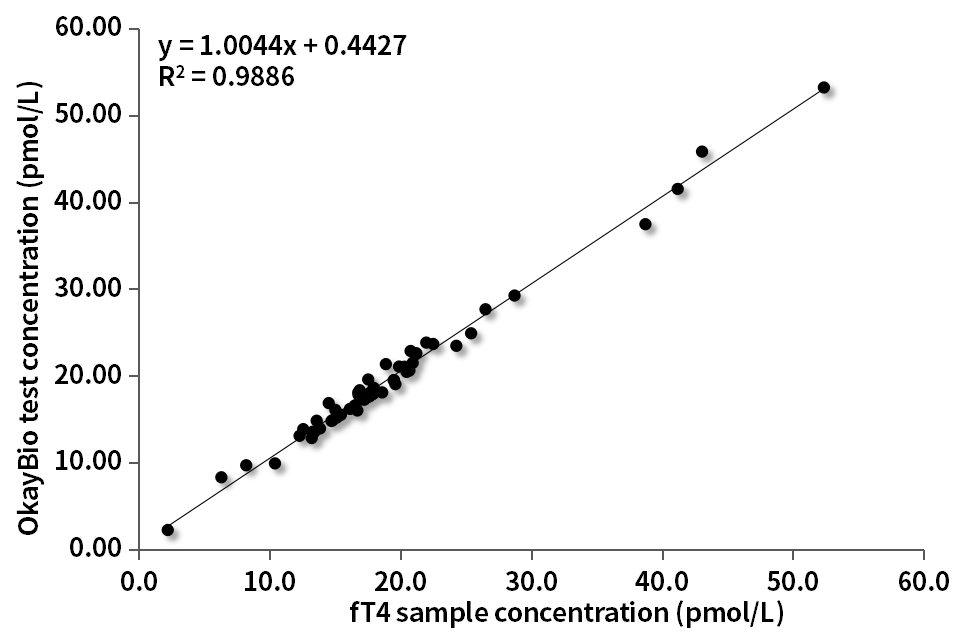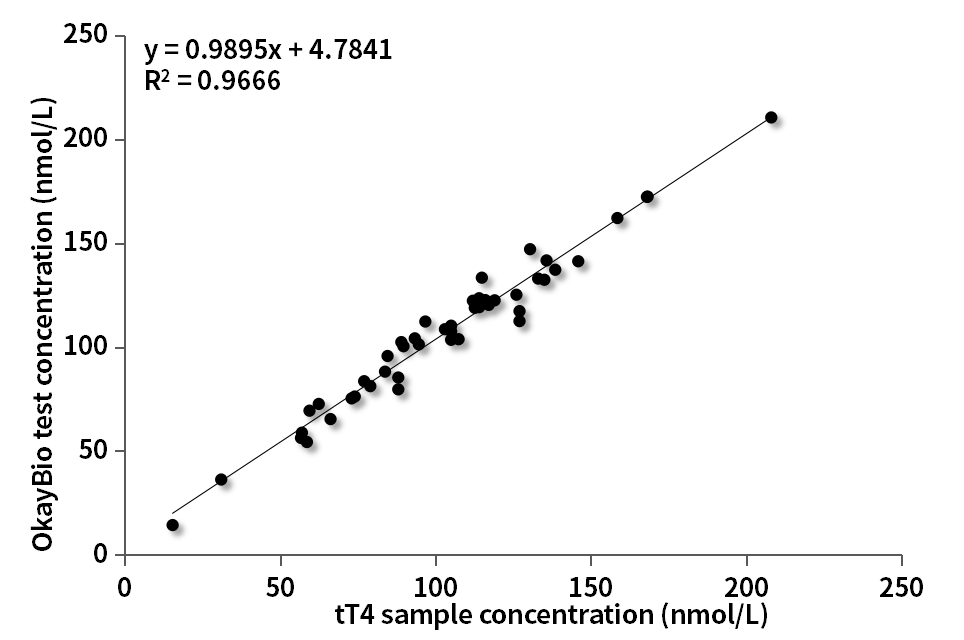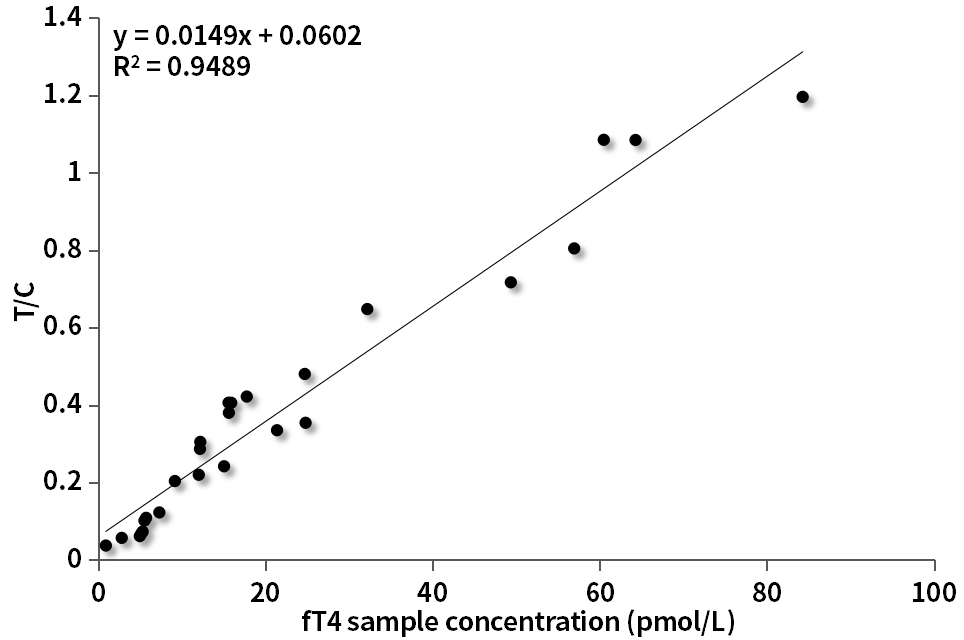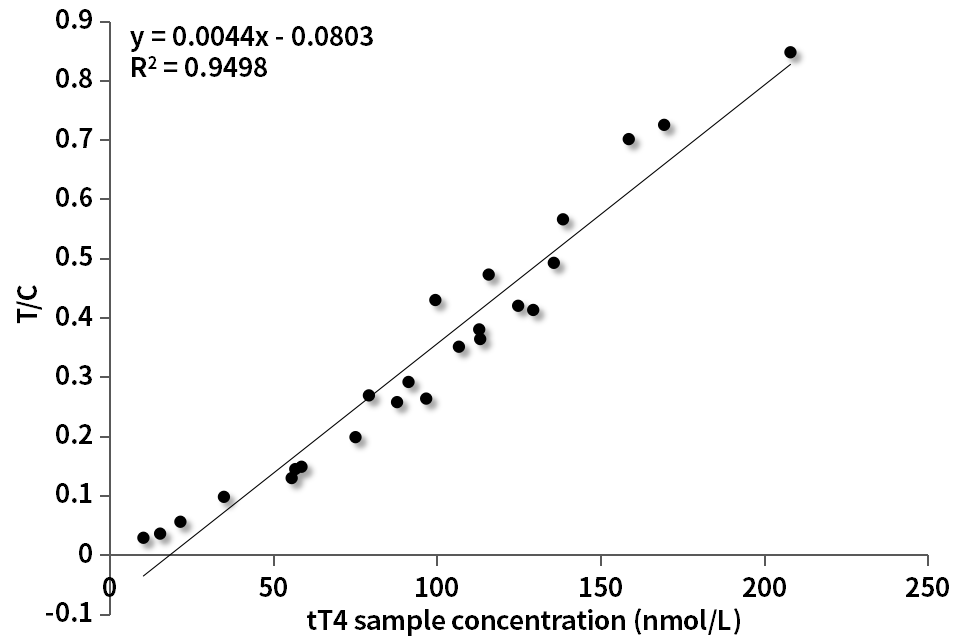| Name | Thyroxine (T4) antibody | |||||
| Catalog # | R533c3 | R534a7 | R555a5 | |||
| Type | Rabbit monoclonal antibody | |||||
| React Species | Human | |||||
| Platforms | Chemiluminescent Immunoassay (CLIA) | Immunochromatography assay (ICA) | ||||
| Platforms | R555a5 (Capture) - R534a7 (Detection) R555a5(Capture) - R533c3 (Detection) |
R533c3 (Capture) - R555a5 (Detection) R534a7 (Capture) - R555a5 (Detection) |
||||
| Purity | Purity>95%, purified by Protein A/G chromatography | |||||
| Buffer | 1 x PBS, pH 7.4 | |||||
| Storage | Aliquot and store at -20°C or lower. Avoid freeze / thaw cycles. | |||||
Roche assigned fT4/tT4 clinical samples were tested via the R555a5 (Capture)- R534a7 (Detection) pair on direct Chemiluminescent Immunoassay (CLIA) platform with coincidence rate R2>0.96.
| Sample | Concentration (pmol/L) |
RLU |
| 1 | 0.000 | 3384 |
| 2 | 4.63 | 225668 |
| 3 | 11.38 | 516982 |
| 4 | 19.25 | 865801 |
| 5 | 52.25 | 2376942 |
| 6 | 102.50 | 4750644 |
Table 1. fT4 Clinical comparison analysis data on CLIA

Figure 1. fT4 Standard curve on CLIA
| Sample | Concentration (pmol/L) |
RLU |
| 1 | 0.000 | 3055 |
| 2 | 20.86 | 229219 |
| 3 | 41.65 | 422718 |
| 4 | 85.96 | 893682 |
| 5 | 120.12 | 1233027 |
| 6 | 302.40 | 3039924 |
Table 2. tT4 Clinical comparison analysis data on CLIA

Figure 2. tT4 Standard curve on CLIA
L-T3 at 10000ng/mL was measured via T4 sandwich antibodies (R555a5-R534a7), and the cross-reactivity was 0.0001%.
Roche assigned fT4/tT4 clinical samples were tested via the R533c3(Capture)-R555a5(Detection) antibody pair on Time-resolved Fluorescent Immunoassay (TRFIA) platform with coincidence rate R2>0.94 .

Figure 3. fT4 Standard curve on TRFIA

Figure 4. tT4 Standard curve on TRFIA
| Concentration (ng/mL) |
T value | C value | T/C |
| 0 | 284 | 32803 | 0.0087 |
| 0.39 | 890 | 32014 | 0.0278 |
| 1.56 | 3512 | 41290 | 0.0851 |
| 6.25 | 9084 | 48322 | 0.1880 |
| 25 | 17370 | 62059 | 0.2799 |
| 100 | 24460 | 52855 | 0.4628 |
| 400 | 47693 | 47258 | 1.0092 |
Table 3. T3 Clinical comparison analysis data on TRFIA
| Concentration (ng/mL) |
T value | C value | T/C |
| 3.2 | 202 | 28510 | 0.0025 |
| 16 | 192 | 20754 | 0.0093 |
| 80 | 472 | 29940 | 0.0158 |
| 400 | 1103 | 24880 | 0.0443 |
| 2000 | 4109 | 25491 | 0.1612 |
Table 4. T3 Cross reactivity data on TRFIA
Thyroxine (T4) is a hormone synthesized by thyroid follicle whose molecular weight is 777 Da, and its secretion is mainly regulated by hypothalamus-pituitary-thyroid axis. Under the stimulation of pituitary thyroid-stimulating hormone, thyroglobulin hydrolyzes and releases T4 into the blood. 99.97% of T4 in the blood binds to thyroid-binding globulin or prethyroid-binding protein, and 0.03% exists in free state. The sum of free thyroxine (FT4) and dissociativethyroxine is called total thyroxine (TT4). FT4 and TT4 are commonly measured in clinical diagnosis.
